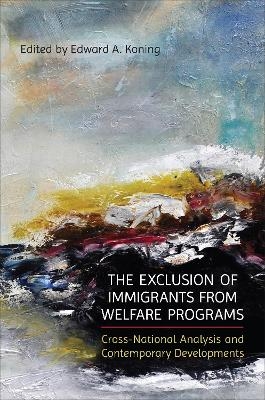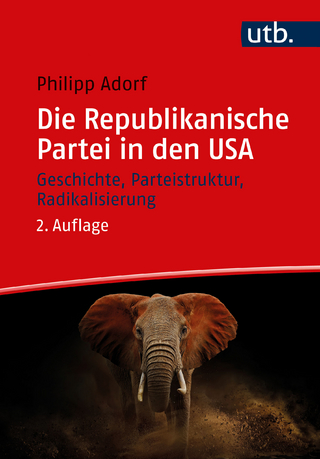
The Exclusion of Immigrants from Welfare Programs
University of Toronto Press (Verlag)
978-1-4875-4634-2 (ISBN)
In light of the increase in cross-border mobility and the recent political climate surrounding immigration-related issues, understanding the politics and policies of immigrants’ access to welfare programs is more relevant than ever. Systematic analysis of this subject has been held back, however, by the lack of a cross-national index of immigrant exclusion from social benefits over time.
The Exclusion of Immigrants from Welfare Programs fills this gap by taking advantage of a novel and original measure called the Immigrant Exclusion from Social Programs Index (IESPI), which includes twenty-five indicators regarding immigrants’ access to seven different social programs, for twenty-two countries, at four moments in time. The book includes an assessment of key trends, an investigation of the origins and consequences of variation, and four detailed country case studies of particular theoretical interest: Norway, Austria, Portugal, and the United States.
Presenting a cross-national index to facilitate and encourage systematic cross-country comparisons, this book provides insights and data that will allow researchers to probe such questions as the degree to which countries include or exclude immigrants in developing public policies, why some countries are more exclusionary than others, and what the future consequences of this exclusion might be.
Edward A. Koning is an associate professor of political science at the University of Guelph.
Section 1: Setting the Stage
1. Introduction
Edward Anthony Koning
Existing Literature and Theoretical Framework
Organization of the Volume
2. The IESPI and Descriptive Findings
Edward Anthony Koning
Conceptualization and Purpose
Methods of Data Collection
Components of the IESPI
Descriptive Findings
Section 2: Quantitative Analyses
3. The Drivers of Exclusion
Friederike Römer and Liv Bjerre
Explanations of Variation in Immigrant Welfare Access
Data
Method and Results
Conclusion and Discussion
4. Appeasement via Exclusion? Differential Access to Social Programs and Their Effects on Xenophobia, Racism, and Perceived Welfare Abuse
Markus M.L. Crepaz
Overview: Social Programs and Their Effect on Crafting National Identities
Trading off Universal Protection in a Closed Immigration System with Selective Protection in an Open Immigration System?
The Relevance of Political Discourse on Welfare Access
Research Design and Variables
Hypotheses
Results
Conclusions and Implications
5. Closing the Gaps: The Positive Effects of Welfare Inclusion on Immigrants’ Labor Market Integration
Anil Duman, Martin Kahanec, and Lucia Mýtna Kureková
Literature Review
Hypotheses
Data and Methodology
Results
Conclusions
6. It Ain’t about the Money: A Cross-Country Study on Fiscal Implications of Immigrant Exclusion
Tsewang Rigzin and Neeraj Kaushal
Literature Review
Data
Descriptive Results
Multivariate Analysis
Conclusions and Discussions
Section 3: Case Studies
7. Between Equality and Exclusion: Migrant Integration into Austria’s Bismarckian Welfare System
Oliver Gruber
The Evolution of the Austrian Welfare State and the Role of Immigration
Welfare System Reform and Migrant Integration in Austria since the 1990s
Public Opinion and Outcomes
Conclusion: Differential Integration and Persistent Reluctance in a Constrained Scope of Action
8. Inclusion under Pressure, The Case of Norway
Grete Brochmann
The Historical Legacy
Why Choosing the Inclusive Avenue?
The Norwegian Integration Approach
Successful Inclusion?
The Problem and the Solution
Attitudes in the Majority Population
Inclusiveness under Strain: Concluding Remarks
9. From Exclusion to More Exclusion: Immigration and Social Welfare Access in the United States
Jason E. Kehrberg, Adam M. Butz, and Mikhala L. West
The American Context
Immigration and Development of the US Welfare State
Increasing American Exclusion with IEWRs: The Personal Responsibility Work Opportunity Reconciliation Act of 1996
Impact of PRWORA on Non-citizen Caseloads across Four US Social Programs
Congressional Gridlock, Sub-national Actors, and Executive Action: 2000 to 2020
A Patchwork of Immigration Policies: American Federalism
Diverging Immigration Attitudes
Immigration Levels in a Period of Congressional Gridlock and Sub-federal Activity
Two Sides of the Same Coin: Obama and Trump Executive Action
Conclusion: The Future of Immigration and Welfare Exclusion in the US
10. Why Choose the Inclusionary Path? Social Policy in a Recent Welfare and Immigration Country: The Case of Portugal
Catarina Reis Oliveira and João Peixoto
Creating the Inclusionary Portuguese Welfare State
Portugal’s Migratory Experience and Immigrants’ Characteristics
The Developments and Achievements of Immigrant Integration Policies over Time
Immigrants’ Inclusion Outcomes: Achievements and Challenges
Immigration Endorsement in Portugal
Conclusions
Section 4: Concluding Reflections
11. Welfare and Immigration: Factoring-in the Neoliberal Order
Christian Joppke
12. Philosophies of Inclusion and Exclusion
Will Kymlicka
13. Conclusions: Is an Inclusive Multicultural Welfare State a Feasible Project?
Keith G. Banting
Inclusion and Exclusion: The Trajectory
The Drivers of Inclusion/Exclusion
Consequences of Inclusion/Exclusion
The Overall Patterns
Concluding Reflections: The Feasibility of an Inclusive Multicultural Welfare State
Appendix: Detailed Country Descriptions
Bibliography
| Erscheinungsdatum | 17.08.2022 |
|---|---|
| Zusatzinfo | 53 b&w figures, 24 b&w tables |
| Verlagsort | Toronto |
| Sprache | englisch |
| Maße | 165 x 235 mm |
| Gewicht | 840 g |
| Themenwelt | Sozialwissenschaften ► Politik / Verwaltung ► Vergleichende Politikwissenschaften |
| Sozialwissenschaften ► Soziologie | |
| ISBN-10 | 1-4875-4634-3 / 1487546343 |
| ISBN-13 | 978-1-4875-4634-2 / 9781487546342 |
| Zustand | Neuware |
| Haben Sie eine Frage zum Produkt? |
aus dem Bereich


